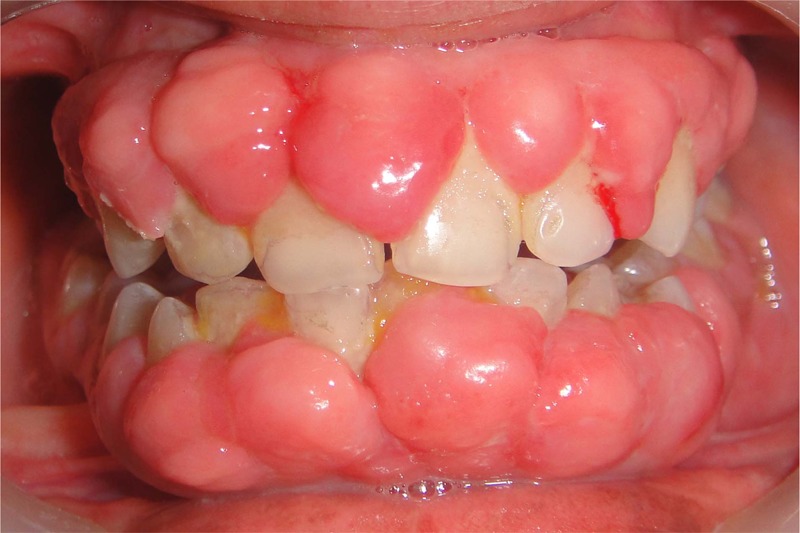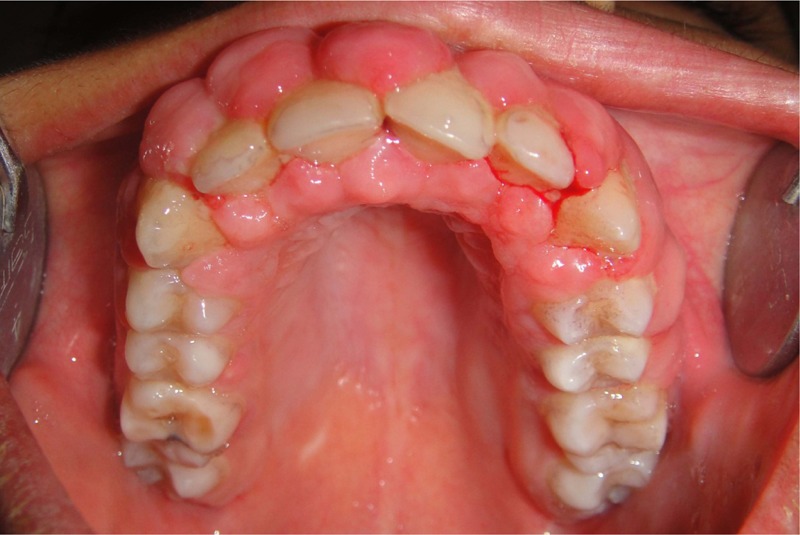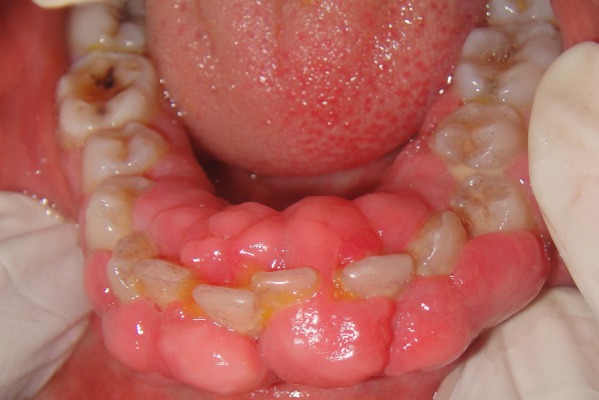Abstract
Drug-induced gingival enlargement is the term now used to describe medication-related gingival hypertrophy or hyperplasia, a condition commonly induced by three main classes of drugs: anticonvulsants, antihypertensive calcium channel blockers and the immunosuppressant cyclosporine. The pathogenesis of drug-induced gingival enlargement is uncertain and there appears to be no unifying hypothesis that links together the three commonly implicated drugs. Phenytoin-induced gingival overgrowth is a well known and frequently reported gingival lesion, which was first detected in 1939. This case report consists of phenytoin usage, duration and poor oral hygiene.
Background
Gingival enlargement is a common clinical feature of gingival and periodontal diseases. It is not an uncommon side effect of certain systemic drugs. Currently, more than 20 prescription medications are associated with gingival enlargement.1 Earlier gingival hyperplasia or gingival hypertrophy term was used to designate drug-induced gingival overgrowth. Since gingival overgrowth was not merely due to increase in number of cells or increase in the size but due to an inflammatory component, the term gingival enlargement or overgrowth is preferred.2 It is important that health practitioners are aware of the potential aetiological agents and characteristic features to accurately diagnose and successfully manage such patients. Drug-induced gingival enlargement was first reported in 1939 by Kimball3 with chronic usage of the antiepileptic drug phenytoin (PHT) mainly administered during epilepsy. Interactions between simultaneously administered medications affecting gingival enlargement have also been reported. All drugs have unwanted effects and the morbidity of gingival enlargement needs to be compared with other possible unwanted effects arising from alternative medication. In the following case report PHT-induced gingival enlargement could have been minimised with the alternative drug and also in reducing dosage.
Case presentation
A 30-year-old man, who had grade II gingival swelling, came to the department of oral medicine. The patient had not received any prior dental therapy. He began to use PHT at an age of 11 years and was still continuing at the time he visited dental department. Patient is epileptic since 17 years and is undertaking PHT upto 800 mg. On intraoral examination moderate swelling was evident with bleeding on probing in both upper and lower anterior. The papillae were swollen and covering more than cervical third of the tooth (figures 1–3).
Figure 1.

Frontal view.
Figure 2.

Palatal view.
Figure 3.

Lingual view.
Discussion
Epilepsy is a disease where a person has recurrent seizures due to a chronic underlying process. The currently available antiepileptic drugs act either by depressing the neuronal activity at the focus of origin or by blocking the spreading mechanisms, PHT (5,5-diphenylhydantoin) was first introduced as an antiepileptic drug in 1938. It is slowly absorbed from the gastrointestinal tract, and shows marked interindividual variation. PHT is known to concentrate in the brain, at levels 5–10 times that found free in the serum.4 The drug is extensively metabolised in the liver by microsomal enzymes, with the major metabolite (50.5% of the PHT dose) being 5 (p-hydroxyphenyl—5PPHH). The drug has been proposed to act via stabilisation of the neuronal cell membrane and through suppression of synaptic transmissions. Depending on the membrane conditions, the drug concentration and the timing, it appears that PHT acts by affecting the (NaK) pump, Ca transport or the sodium influx at a cellular level.5 6
Gingival overgrowth is one of the most common side effects associated with the administration of PHT, the most frequently used antiepileptic drug. The prevalence of PHT-induced gingival overgrowth has been shown to vary, from 13% to 50%, in community-based studies on institutionalised patients. In the above case the patient's poor oral hygiene had an adjunctive effect over PHT tissue response thereby causing gingival enlargement.7
Learning points.
The prevention and management of drug-induced gingival enlargement remains unsatisfactory. The problem is compounded by the high recurrence rate arising from chronic usage of the listed medications and persistence of risk factors.
The feasibility of discontinuing the drug and replacing with a suitable alternative should be discussed with the physician.
Carbamazepine, ethosuximide and sodium valproate are alternatives to phenytoin which have been shown not to cause drug-induced gingival enlargement.
Clinically, gingival overgrowth is almost exclusively related to dentate areas which suggest that factors such as dental plaque and gingival inflammation may be important in the development of the condition. Several clinical reports have confirmed that in susceptible individuals overgrowth is most severe in the presence of gingival inflammation.
Constant monitoring of the dose response should be keenly undertaken.
Footnotes
Competing interests: None.
Patient consent: Obtained.
Provenance and peer review: Not commissioned; externally peer reviewed.
References
- 1.Rees TD, Levine RA. Systemic drugs as a risk factor for periodontal disease initiation and progression. Compend Contin Educ Dent 1995;2013:20–42 [PubMed] [Google Scholar]
- 2.Newman C. Glickman's clinical periodontology. 8th edn. Philadelphia, USA: WB Saunders Co. 1997:233 [Google Scholar]
- 3.Kimball OP. The treatment of epilepsy with sodium diphenyl hydantoinate. J Am Med Assoc 1939;2013:1244–5 [Google Scholar]
- 4.Angelopoulos AP. Diphenhydantoin gingival hyperplasia. A clinicopathological review. Incidence, clinical features and histopathology. J Can Dent Assoc 1975;2013:103–6 [PubMed] [Google Scholar]
- 5.Panuska HJ, Gorlin RJ, Bearman JE. The effect of anti convulsants drugs upon the gingiva: a series of 1048 patients. J Periodontol 1961;2013:15–20 [Google Scholar]
- 6.Lowenstein DR. Seizures and epilepsy. In: Fanci AS, Braunwald E, Isselbacher KJ, et al. Harrison's principles of internal medicine. New York: McGraw-Hill, 1991:23l1–2r [Google Scholar]
- 7.Brunet L, Miranda J, Roset P, et al. Prevalence and the risk of gingival enlargement in patients treated with anticonvulsant drugs. Fur J Clin Invest 2001;2013:781–8 [DOI] [PubMed] [Google Scholar]


